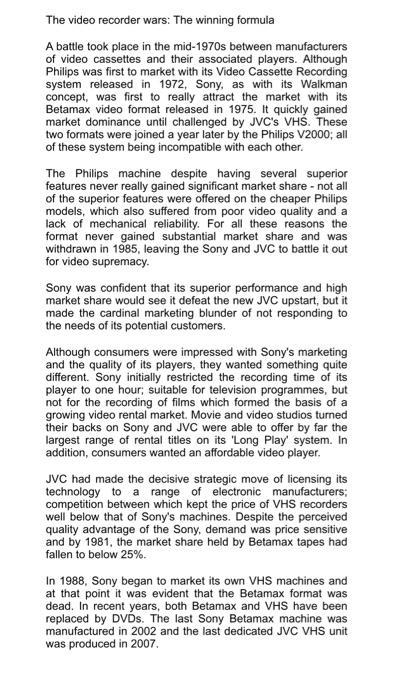Answered step by step
Verified Expert Solution
Question
1 Approved Answer
The video recorder wars: The winning formula A battle took place in the mid-1970s between manufacturers of video cassettes and their associated players. Although


The video recorder wars: The winning formula A battle took place in the mid-1970s between manufacturers of video cassettes and their associated players. Although Philips was first to market with its Video Cassette Recording system released in 1972, Sony, as with its Walkman concept, was first to really attract the market with its Betamax video format released in 1975. It quickly gained market dominance until challenged by JVC's VHS. These two formats were joined a year later by the Philips V2000; all of these system being incompatible with each other. The Philips machine despite having several superior features never really gained significant market share - not all of the superior features were offered on the cheaper Philips models, which also suffered from poor video quality and a lack of mechanical reliability. For all these reasons the format never gained substantial market share and was withdrawn in 1985, leaving the Sony and JVC to battle it out for video supremacy. Sony was confident that its superior performance and high market share would see it defeat the new JVC upstart, but it made the cardinal marketing blunder of not responding to the needs of its potential customers. Although consumers were impressed with Sony's marketing and the quality of its players, they wanted something quite different. Sony initially restricted the recording time of its player to one hour; suitable for television programmes, but not for the recording of films which formed the basis of a growing video rental market. Movie and video studios turned their backs on Sony and JVC were able to offer by far the largest range of rental titles on its 'Long Play' system. In addition, consumers wanted an affordable video player. JVC had made the decisive strategic move of licensing its technology to a range of electronic manufacturers; competition between which kept the price of VHS recorders well below that of Sony's machines. Despite the perceived quality advantage of the Sony, demand was price sensitive and by 1981, the market share held by Betamax tapes had fallen to below 25%. In 1988, Sony began to market its own VHS machines and at that point it was evident that the Betamax format was dead. In recent years, both Betamax and VHS have been replaced by DVDS. The last Sony Betamax machine was manufactured in 2002 and the last dedicated JVC VHS unit was produced in 2007. Research the format war between Sony and JVC and answer the following question: Using the example of the video recorder market. Suggest how Sony could have maintained the competitive advantage of its Betamax format over the rival VHS system.
Step by Step Solution
★★★★★
3.42 Rating (165 Votes )
There are 3 Steps involved in it
Step: 1
When it was first released in 1975 Betamax had 100 percent market share in the home video market because it was the only piece of technology for that ...
Get Instant Access to Expert-Tailored Solutions
See step-by-step solutions with expert insights and AI powered tools for academic success
Step: 2

Step: 3

Ace Your Homework with AI
Get the answers you need in no time with our AI-driven, step-by-step assistance
Get Started


